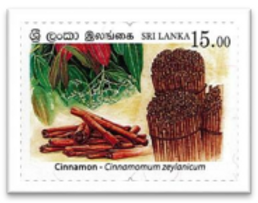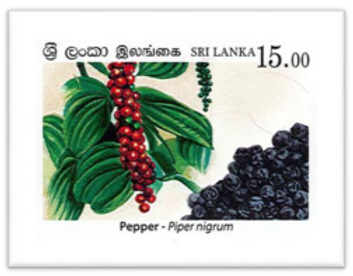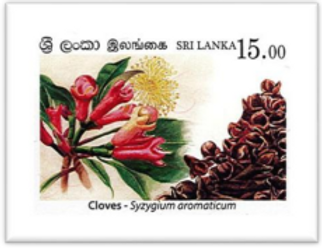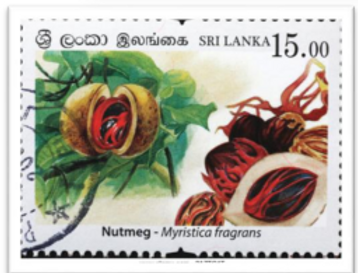Spices of Sri Lanka
Spices of Sri Lanka
The Philatelic Bureau of the Department of posts issued four new postage stamps depicting four major spices of Sri Lanka, Cinnamon, Pepper, Clove and Nutmeg.
•Date of Issue: 26th February 2019
•Denominations: Rs. 15.00 x 4
•Stamp Designer: Palitha Gunasinghe
Cinnamon

Cinnamon Plant which is an evergreen perennial crop is known by the scientific name, CInnamomum zeylanicum.It is cinnamon which is more important among the economically important crop indigenous to Sri Lanka. Particularly the Sri Lankan cinnamon is considered the best variety in the world and it is Sri Lanka who supplies the largest quantity of genuine cinnamon to the world market. Cinnamon has originated around the central hills of Sri Lanka and even now cinnamon cultivation is spread in areas like Kandy, Mathale, Belihuloya, Hapithale and in certain parts of the Sinha raja forest as well. Cinnamon cultivation is also found along the coastal belt from Kaluthara to Beliatta and from there to the interior up to Rathnapura. The districts of Badulla, Hambantota, Colombo and Gampaha too are famous for cinnamon cultivation. It is mentioned in Ayurveda that cinnamon is capable of containing heart diseases and diabetes.
Pepper

Pepper which accounts for a higher quantity and a higher value in the international spices trade is known by the term “The King of Spices”. Termed Piper nigrum botanically, pepper is the spices mostly used throughout the world it is the mature small and dried pepper seed which is more important economically while the annual demand for pepper is around 200,000 metric tons, it amounts to around 1/3 of the volume of world spices trade. Out of the total pepper imports almost 90% is supplied by countries such as Indonesia, India, Vietnam, Malaysia and Brazil. Among the pepper growing districts in Sri Lanka Mathale, Kandy,, Badulla, Rathnapura, Kurunegala and Nuwara Eliya districts stand prominent. At present pepper is being cultivated in a land area of approximately 30,000 hectares. The cultivation can be done by the use of live or non-live supports as a single crop or a mixed crop among tea and coconut cultivations. It is mentioned Ayurveda that pepper prevents indigestion and phlegmatic disorders.
Clove

Flowers which are fully grown yet not open in the inflorescences of Eugenia caryophyllata tree belonging to the family Myrtaceae known in the botanical name Syzygium aromaticumare suitable for the tradeoff cloves when they are dried. The stems which bore the flowers and the leaves too have a commercial value. Flowers are born in small terminal inflorescences numbering 3-10. A single inflorescence consists of 3 flowers. The calyx is made of a soft ovary at the top of which are four triangular sepals. Around the stamens of the bud there are four red petals. Cloves grow very luxuriantly in wet tropical climatic areas and an annual rainfall of 1750-2500 mm is suitable for clove cultivation. According to Ayurveda, cloves are efficacious in tooth diseases, cures dyspepsia and controls gas and bile.
Nutmeg

The nutmeg plant known by the botanical name Myristica fragranswas introduced to Sri Lanka around the 19th century. An evergreen plant which grows to a height of about 15-20 meters, its leaves are dark green in color. Nutmeg fruits are fleshy and hang down from the tree. There are grooves around the fruit and when ripe it turns yellow and splits from the top along the groove and opens showing the shiny seed which is covered over by a crimson network, the mace. Matale, Kandy, Kegalle, Badulla and Nuwara Eliya. In village gardens both nutmeg and clove trees can be seen together. It is mentioned in Ayurveda that nutmeg controls gas, effective in coagulation of blood, cures gastric disorders and mouth and urine diseases.
Shinal Amarathunga



 Prefects
Prefects